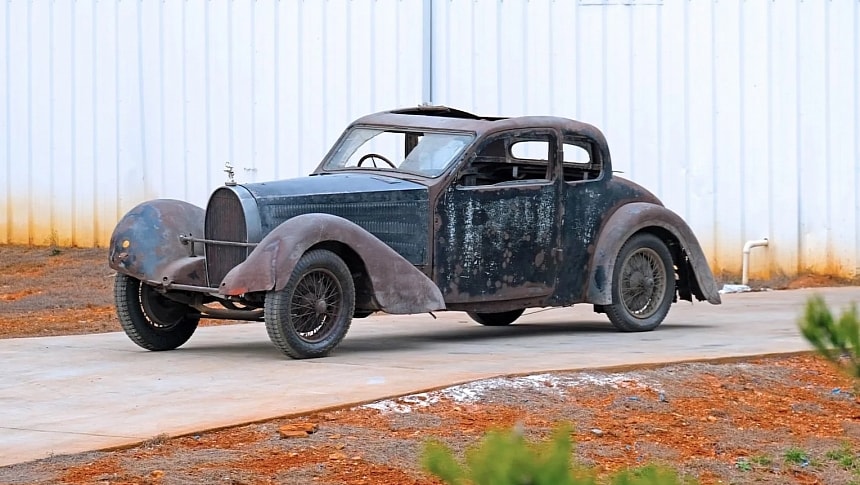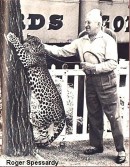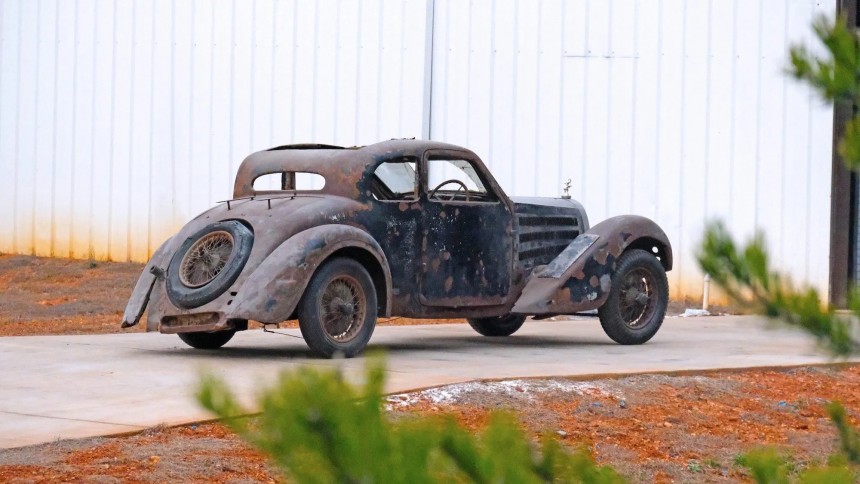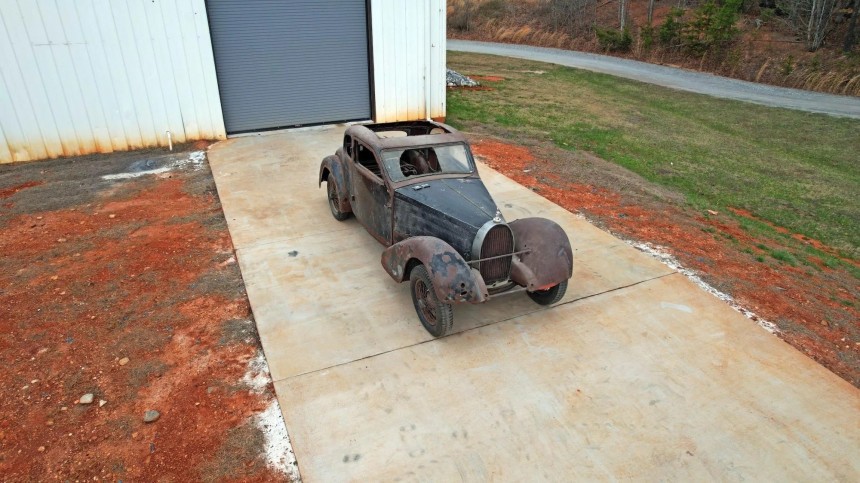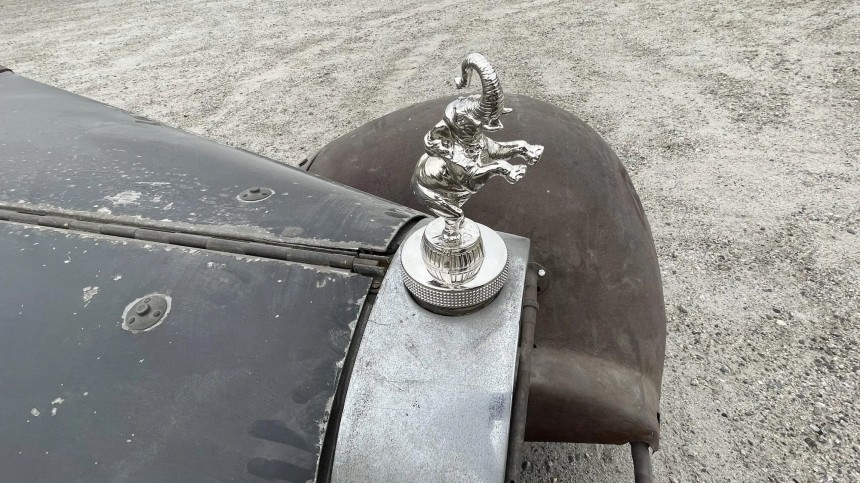This 1936 Bugatti Type 57 has been through quite a lot. The way its body looks right now stands proof. However, its impressive background failed to impress, and the car did not meet the reserve when it was auctioned off last month. The almost nine-decade-old automobile has had its logo changed for a very strange reason.
What car is that? The logo doesn't look familiar. But somehow, the story of this car makes sense. It is a Bugatti Type 57, chassis number 57364, one of the approximately 700 such examples that rolled off the production line between 1934 and 1940.
This car saw the light of day in January 1936. It was ordered new by Circus Binder director and animal tamer Roger Spiessert with Jean Bugatti-designed Ventoux four-light coupe coachwork for 30,000 French Francs and registered for the first time in Bordeaux, France.
Roger Spiessert was not your usual businessman. He was the one who replaced the Bugatti logo with a prancing elephant statuette to advertise his circus. Spiessert was hauling elephants with the Bugatti Type 57. To promote the shows, he trailered an elephant calf around.
However, he did not keep it much and sold it that same year to head of police, Deputy Jean Gapiand, in Saint-Just-sur-Loire and then again the following year to Parisian Marc Le Put. The automobile was eventually found abandoned in Paris in the 1950s. John Harrison fell in love with it, and in 1959, he had it shipped to Los Angeles, California.
It then changed hands several times until, in 1978, David Davies considered it was a keeper and kept it in storage for four decades. He sold it in 2018 to its current owner.
The rolling chassis with steel bodywork retains the worn-out black paint with massive rust. The three-row bonnet louvers are still there. The model has lost its bumpers over the years but kept the luggage handles of the small trunk compartment and flush-mounted rear spare wheel with a seriously damaged Michelin tire.
The polished prancing elephant radiator mascot is the only component still shining on this car. The statuette was reportedly commissioned by the original owner, Roger Spiessert, and polished when he was preparing the car for sale, so that explains why it looks decades younger than the rest of the vehicle.
It rides on 18-inch wire wheels with mechanically actuated finned aluminum drum brakes and cracked mismatched tires at the rear and 5.50-18 Excelsior Comp H tires at the front.
The horseshoe-shaped radiator shell with thermostatically controlled shutters has survived. However, the 3,257 cc DOHC straight-eight engine is only partially under the hood, in the company of the Stromberg updraft carburetor, and mated to a four-speed manual transmission.
To give it a new lease of life, someone must really fall in love with this car, pay a fortune for it, trailer it to some shop, and invest an even larger fortune to restore it to factory condition. But that is hundreds of thousands of dollars away.
The Bugatti Project Type 57 Ventoux is offered on a dealer consignment in Sunnyside, North Carolina, with an in-transit Montana title. It failed to meet the reserve the last time it was auctioned off, as the last bid hit $176,600. We’re not told, though, how high the reserve sits right now.
However, the price includes side windows, Scintilla headlights, five additional wire wheels, and various trim pieces that have been removed from the car. The rear window is missing, though. And so are the fuel-filler cap and left-front and rear fender braces.
Whoever will take it home to brag about it after that fortune invested into restoration and then show off at concours d'elegance events around the world, must know that the Type 57 was designed by Jean Bugatti, son of Ettore.
Two body configurations were available, built either in-house or by Swiss/French coach-builder Gangloff. One of the three body styles was Ventoux, with the name inspired by the Alpine peaks. It was a four-seat coupe with two rear-hinged doors and two or four side windows.
The Bugatti we are looking at has been consumed by corrosion. The windshield is partially missing. The fabric roof is missing, too, and the cabin is stripped of much of what used to be in there. The four-spoke wooden steering wheel with a St. Cristopher's badge is still in place.
A refurbished Jaeger speedometer with inset gauges monitoring fuel level, amperage, oil pressure, and coolant temperature is included in the sale, along with a Jaeger clock. In its good old days, this car was capable of driving as fast as 170 kph (106 mph), but the mileage remains unknown.
There is a plaque on board that displays the name of the car's first owner. The future owner can replace it with their name once the restoration is complete.
This car saw the light of day in January 1936. It was ordered new by Circus Binder director and animal tamer Roger Spiessert with Jean Bugatti-designed Ventoux four-light coupe coachwork for 30,000 French Francs and registered for the first time in Bordeaux, France.
Roger Spiessert was not your usual businessman. He was the one who replaced the Bugatti logo with a prancing elephant statuette to advertise his circus. Spiessert was hauling elephants with the Bugatti Type 57. To promote the shows, he trailered an elephant calf around.
However, he did not keep it much and sold it that same year to head of police, Deputy Jean Gapiand, in Saint-Just-sur-Loire and then again the following year to Parisian Marc Le Put. The automobile was eventually found abandoned in Paris in the 1950s. John Harrison fell in love with it, and in 1959, he had it shipped to Los Angeles, California.
The rolling chassis with steel bodywork retains the worn-out black paint with massive rust. The three-row bonnet louvers are still there. The model has lost its bumpers over the years but kept the luggage handles of the small trunk compartment and flush-mounted rear spare wheel with a seriously damaged Michelin tire.
The polished prancing elephant radiator mascot is the only component still shining on this car. The statuette was reportedly commissioned by the original owner, Roger Spiessert, and polished when he was preparing the car for sale, so that explains why it looks decades younger than the rest of the vehicle.
It rides on 18-inch wire wheels with mechanically actuated finned aluminum drum brakes and cracked mismatched tires at the rear and 5.50-18 Excelsior Comp H tires at the front.
To give it a new lease of life, someone must really fall in love with this car, pay a fortune for it, trailer it to some shop, and invest an even larger fortune to restore it to factory condition. But that is hundreds of thousands of dollars away.
The Bugatti Project Type 57 Ventoux is offered on a dealer consignment in Sunnyside, North Carolina, with an in-transit Montana title. It failed to meet the reserve the last time it was auctioned off, as the last bid hit $176,600. We’re not told, though, how high the reserve sits right now.
However, the price includes side windows, Scintilla headlights, five additional wire wheels, and various trim pieces that have been removed from the car. The rear window is missing, though. And so are the fuel-filler cap and left-front and rear fender braces.
Two body configurations were available, built either in-house or by Swiss/French coach-builder Gangloff. One of the three body styles was Ventoux, with the name inspired by the Alpine peaks. It was a four-seat coupe with two rear-hinged doors and two or four side windows.
The Bugatti we are looking at has been consumed by corrosion. The windshield is partially missing. The fabric roof is missing, too, and the cabin is stripped of much of what used to be in there. The four-spoke wooden steering wheel with a St. Cristopher's badge is still in place.
A refurbished Jaeger speedometer with inset gauges monitoring fuel level, amperage, oil pressure, and coolant temperature is included in the sale, along with a Jaeger clock. In its good old days, this car was capable of driving as fast as 170 kph (106 mph), but the mileage remains unknown.
There is a plaque on board that displays the name of the car's first owner. The future owner can replace it with their name once the restoration is complete.
